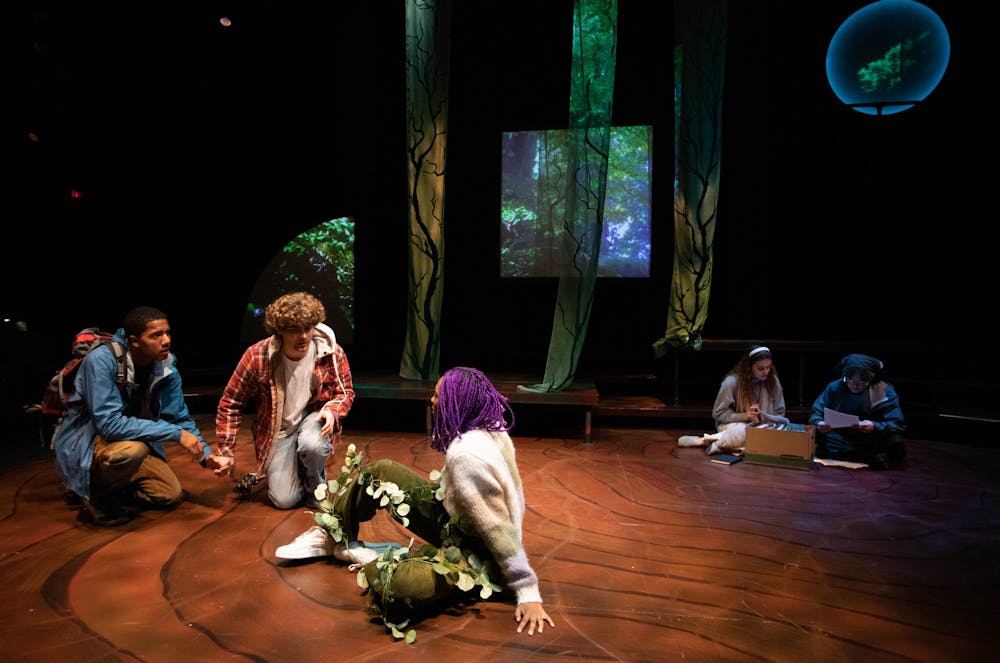Nearly every part of the set of “The Living Ones” — a sustainably produced play about key social and environmental issues facing young people that takes place amid devastating forest fires in the Pacific Northwest — played two roles. Its two bedrooms could become part of a forest, a stump could also be a chair and fabric trees could be there one second and gone the next.
“I knew the design would be a super important part of the show because the forest is like another, seventh character,” Madeleine Adriance ’23.5, the play’s author, said. “I’m super proud of how it turned out.”
The play, performed from Dec. 8 to Dec. 11 in Leeds Theatre, follows six central characters spanning multiple generations. According to the program, these characters are “four teenagers on the brink of uncertain futures” and “two siblings (grappling) with the mystery of their recently deceased mother” years later. Naming Tony Kushner’s “Angels in America” as a major inspiration, Adriance said she also wanted to “make meaning of national and existential themes by telling the stories of queer people.”
“The Living Ones”’ was a senior slot production, meaning that it was a project conceived of by a student and produced with resources and support from the Department of Theatre Arts and Performance Studies. TAPS concentrators may apply in the spring of their junior year for their plays to be produced the following fall semester.
Many applicants are directors hoping to work with pre-existing works. Adriance, however, applied with an original work and no director attached. “It was a more unconventional proposal,” she said.
But with the help of the department, Adriance found a director, designers, actors and everything else she needed to get her play produced and performed.
“An advantage of the department producing new work is that it’s this amazing learning opportunity to see something go from script to stage for the first time ever,” she said. “You get to work on something no one else in your position has ever worked on before.”
Maxime Hendrikse Liu ’23, whom Adriance had previously met at a theater camp before arriving at Brown, was brought on to direct the play.
When she was offered the position of director, “I was absolutely very honored, even more so after I read the script,” Liu said. “I actually told (Adriance), ‘If I don’t apply to direct this show I will regret it for the rest of my life,’” she recalled.
Ford Haley-Rowe ’24, the production’s set designer, said that the way he observed actors using his set pieces in rehearsals helped inform further design choices. For example, “seeing the actors use the stump platform as though it was a piece of furniture gave the scene a magical realism effect,” he said. “I wanted to create something the actors could interact with and be creative.” In this way, Haley-Rowe added, his creative process was collaborative even after he had finished part of his design.
He also sought to advance the production-wide value of sustainability through the creation of his designs. “I knew exeriments with green theater (were) going to be a really cool challenge,” Haley-Rowe said. Noting that sets he had previously worked on produced wood waste, he grappled with the question, “if this is a play about environmentalism, how do we build sets out of wood in a way that is sustainable?”
This commitment to sustainability also extended to “the actors and labor and time that people are putting in,” Liu said. “We wanted to prioritize the actors’ health — both physical and mental — (as) much as we prioritized our own story.”
Liu “created a really lovely rehearsal space that empowered people to be their most creative selves,” Adriance said. The cast and crew included a diverse range of perspectives, welcoming contributors of all backgrounds and identities and with varying degrees of theater experience, she added.
As for audience impact, Adriance knew she couldn’t expect any specific takeaways.
“You can’t control what audiences get out of something or how they interpret it,” she said. “I just hope people come away feeling like we do have the power to change things and understand that our actions ripple out in a way that we can’t anticipate and affect other people.”
Ultimately, while Adriance would like to have the play produced again, possibly in the Pacific Northwest where it is set, she expressed a desire to move on to new projects.
“I’m going to write one more draft and then I’m going to move on,” she said. “I have other things to write.”
Adriance, who worked on the script throughout her time at Brown, said that “there are things that I learned about the play throughout this process that I wish I knew earlier, but of course I needed to go through this process to learn those things.”
In future work, Adriance will apply the lessons she learned from writing “The Living Ones” as she continues to try to “grant agency and dignity to the non-human world.”
Adriance advised other aspiring playwrights considering producing their own work to “find collaborators whose creativity you admire and whose perspective you can trust.”
“Theater is a collaborative art form that sinks or swims on the strength of the people bringing it to life,” she said.





